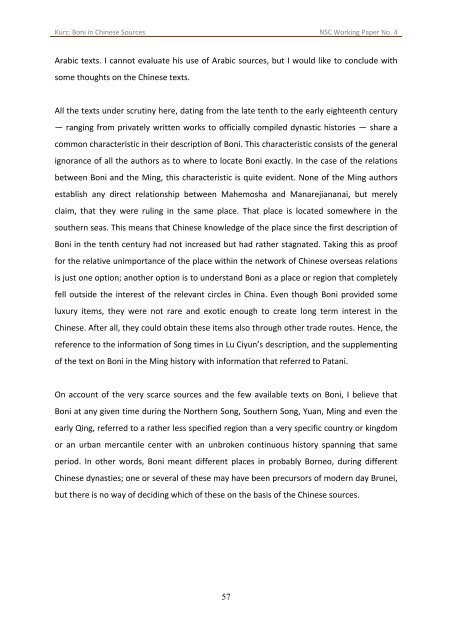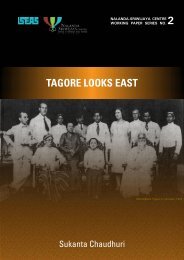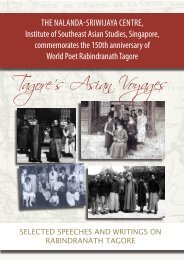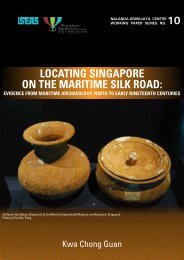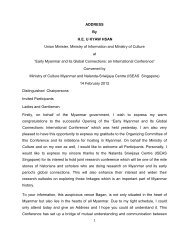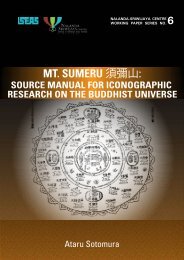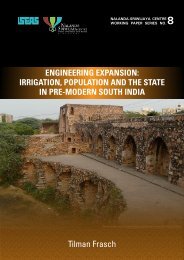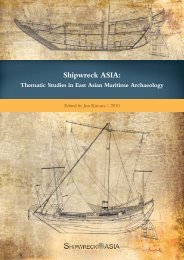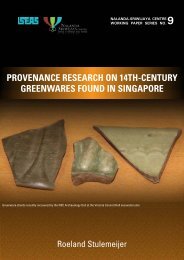Boni in Chinese Sources - Nalanda-Sriwijaya Centre - iseas
Boni in Chinese Sources - Nalanda-Sriwijaya Centre - iseas
Boni in Chinese Sources - Nalanda-Sriwijaya Centre - iseas
Create successful ePaper yourself
Turn your PDF publications into a flip-book with our unique Google optimized e-Paper software.
Kurz: <strong>Boni</strong> <strong>in</strong> Ch<strong>in</strong>ese <strong>Sources</strong> NSC Work<strong>in</strong>g Paper No. 4Arabic texts. I cannot evaluate his use of Arabic sources, but I would like to conclude withsome thoughts on the Ch<strong>in</strong>ese texts.All the texts under scrut<strong>in</strong>y here, dat<strong>in</strong>g from the late tenth to the early eighteenth century— rang<strong>in</strong>g from privately written works to officially compiled dynastic histories — share acommon characteristic <strong>in</strong> their description of <strong>Boni</strong>. This characteristic consists of the generalignorance of all the authors as to where to locate <strong>Boni</strong> exactly. In the case of the relationsbetween <strong>Boni</strong> and the M<strong>in</strong>g, this characteristic is quite evident. None of the M<strong>in</strong>g authorsestablish any direct relationship between Mahemosha and Manarejiananai, but merelyclaim, that they were rul<strong>in</strong>g <strong>in</strong> the same place. That place is located somewhere <strong>in</strong> thesouthern seas. This means that Ch<strong>in</strong>ese knowledge of the place s<strong>in</strong>ce the first description of<strong>Boni</strong> <strong>in</strong> the tenth century had not <strong>in</strong>creased but had rather stagnated. Tak<strong>in</strong>g this as prooffor the relative unimportance of the place with<strong>in</strong> the network of Ch<strong>in</strong>ese overseas relationsis just one option; another option is to understand <strong>Boni</strong> as a place or region that completelyfell outside the <strong>in</strong>terest of the relevant circles <strong>in</strong> Ch<strong>in</strong>a. Even though <strong>Boni</strong> provided someluxury items, they were not rare and exotic enough to create long term <strong>in</strong>terest <strong>in</strong> theCh<strong>in</strong>ese. After all, they could obta<strong>in</strong> these items also through other trade routes. Hence, thereference to the <strong>in</strong>formation of Song times <strong>in</strong> Lu Ciyun’s description, and the supplement<strong>in</strong>gof the text on <strong>Boni</strong> <strong>in</strong> the M<strong>in</strong>g history with <strong>in</strong>formation that referred to Patani.On account of the very scarce sources and the few available texts on <strong>Boni</strong>, I believe that<strong>Boni</strong> at any given time dur<strong>in</strong>g the Northern Song, Southern Song, Yuan, M<strong>in</strong>g and even theearly Q<strong>in</strong>g, referred to a rather less specified region than a very specific country or k<strong>in</strong>gdomor an urban mercantile center with an unbroken cont<strong>in</strong>uous history spann<strong>in</strong>g that sameperiod. In other words, <strong>Boni</strong> meant different places <strong>in</strong> probably Borneo, dur<strong>in</strong>g differentCh<strong>in</strong>ese dynasties; one or several of these may have been precursors of modern day Brunei,but there is no way of decid<strong>in</strong>g which of these on the basis of the Ch<strong>in</strong>ese sources.57


